At the National Centre for Photovoltaic Research and Education (NCPRE), IIT Bombay, the Ministry of New and Renewable Energy (MNRE) outlined India’s progress in developing silicon-perovskite tandem solar cells as part of its 100 GW solar mission. NCPRE was established in 2010 with MNRE funding, receiving over Rs 2 billion over the past 15 years to support research and education. An IIT Bombay-incubated start-up, Advanced Renewable Tandem-Photovoltaics India (ART-PV India), has developed a 4-terminal silicon/cadmium telluride-perovskite tandem solar cell achieving 29.8 per cent conversion efficiency, which is among the highest performance levels reported in India. The MNRE is further supporting ART-PV India with $10 million for setting up a pilot manufacturing facility at the IIT Bombay campus to commercialise this technology.
Through initiatives like the Renewable Energy Research and Technology Development programme and research and development funding schemes, MNRE is focusing on strengthening domestic research and manufacturing in renewable energy technologies. Furthermore, MNRE is providing policy and financial support to advance inverter technology, PV reliability, green hydrogen, and energy storage research in India. The ministry highlighted that the Union Cabinet recently approved the Research Development and Innovation scheme, with India’s gross expenditure on research and development budgeted at Rs 1.27 trillion. The approach aims to reduce dependence on imported technologies and foster indigenous innovations that can be scaled for both domestic and global markets.
MNRE also emphasised the need for commercial demonstration of silicon-perovskite tandem solar cells to ensure scalability and profitability. By establishing a state-of-the-art manufacturing ecosystem, MNRE expects institutions like NCPRE to accelerate lab-to-market transitions, helping India emerge as a global clean energy hub.













